flute
All scores that include a part for at least one flute.
Schnauber - Those Infernal Exsanguinators - Flute and Piano
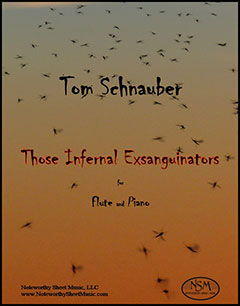 Those Infernal Exsanguinators, by Tom Schnauber
Those Infernal Exsanguinators, by Tom Schnauber
Flute part and Piano score, PDF $17.97
Summer in Minnesota. The sun is setting, the broad sky is clear, and the cool light of dusk promises a welcome respite from the day’s heat and humidity. You step out into the stillness and stand, gazing at the orange-red horizon, thankful for the dimming light and approaching night. And then they come. Those insidious little creatures, those vile insects that define and destroy the season: the mosquitoes. Only some at first, few enough to make you think that if you swat them away, you can still enjoy the evening air. But then more come, and more, and even more. They whine, you moan, they sting, you slap, they swarm, you flail. Soon, your body a mass of swelling welts, you realize that the twilight peace you had hoped for when you left your house is a sham, an impossible illusion shattered by the piercing terror of those infernal exsanguinators. Angry and itching, you run back inside and slam the door shut. —Tom Schnauber
In October, 2020, we at NSM were delighted to welcome Tom Schnauber as one of our contributing contemporary composers; click the link to read about this acclaimed composer's career and his many exciting projects.
Those Infernal Exsanguinators is a compelling piece; to discover this for yourself, please visit Tom Schnauber's soundcloud page and listen to a recording of the work beautifully performed by Tamara Thweatt, flute, and Hey-Seon Choi, piano.
Piano Score, 18 pages; Flute part, 7 pages; Total, 28 pages.
PreviewSchubert - Erlking - Flute, Cello & Piano
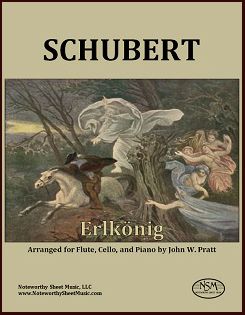 Erlkönig, Franz Schubert
Erlkönig, Franz Schubert
Arranged for Flute, Cello, and Piano by John W. Pratt
Piano Score and Parts for Flute and Cello; PDF $11.99
Franz Schubert (1797-1828), inspired by reading Goethe's poem, wrote his song "Erlkönig" in a few hours in 1815. The song was an immediate hit, and continues to be popular to the present day. Numerous transcriptions have been prepared, but surprisingly none that we found for flute, cello, and piano. John Pratt has created such a trio arrangement, listed here, and also a duet version of the piece with Schubert's solo part adopted without change but with a less punishing alternative to Schubert's piano accompaniment.
Excerpted from Mr. Pratt's © preface:
"In the trio arrangement, the flute provides a natural voice for the child and for the mysterious Erlking, whose words are in the child's head. The cello makes a natural father. The narration is mostly given to the cello also, but the flute takes over when the child is mentioned in bars MM 24-30, and joins the cello when the ride is ending in anguish and distress (MM 139-145). The piano is treated as a member of a trio rather than an accompaniment to a voice singing words. The presence of the cello helps free the piano from the constant pounding and allows it to employ a wider range of expressive sonorities than Schubert's, befitting the absence of words. One might view the result as a kind of tone poem."
Preview
Schubert - Rondo in B minor - Flute (and Piano)
 Rondo in B minor, D.895, by Franz Schubert
Rondo in B minor, D.895, by Franz Schubert
Transcribed for Flute (and Piano) by J.W.Pratt and C.A.Vater
Flute Part, PDF $11.99
The Rondo in B minor, D.895 (alternatively known as Rondeau brillant) was written for violin and piano in 1826 by the great Austrian composer Franz Peter Schubert. Dedicated to the young violin virtuoso Josef Slawjk, the Rondo is demanding in both the solo and piano parts. The work consists of an Andante introduction and an Allegro rondo, and is quite long at 713 measures and typically some thirteen minutes or more in duration. Inexplicably, the piece is less familiar to players and audiences than many of Schubert’s other works. Brian Newbould, renowned composer, conductor, author, and Schubert expert, wrote of the Rondo in his treatise Schubert: The Music and the Man (University of California Press, Jan 1, 1997, p365): “Not surprisingly, perhaps, it is little known because it is seldom played. But it is also undervalued: it scintillates, dances and sings, with a blend of infectious joy, tireless energy, rhythmic zip and ‒ from time to time ‒ heart-melting turns of melody and harmony.”
These characteristics and the way the music realizes them are not only suitable to but often even suggestive of a wind instrument. Our transcription provides effective flute-friendly alternatives for the violin’s double-stops as well as for notes that fall below the flute’s range, so the piece can be played comfortably and beautifully on flute. The Rondo is virtuosic in places, showy and exciting, and overall great fun to play. The Noteworthy Sheet Music edition of our transcribed flute part does not include a re-notated copy of the score, since high-quality PDFs of the piano and violin score are freely available in the public domain and are sufficient to use along with our flute part, in lieu of violin. To download one such PDF of the score, please visit the Rondo’s page on IMSLP.
Flute part, 12 pages; Total 14 pages.
PreviewSchumann, Clara - Three Romances - Alto Flute or Flute (and Piano)
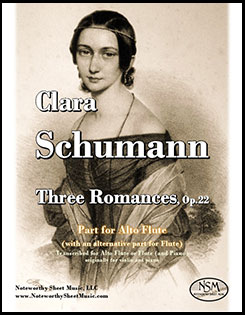 Three Romances, Op.22, by Clara Schumann
Three Romances, Op.22, by Clara Schumann
Transcribed for Alto Flute or Flute (and Piano) by C.A.Vater
Alto Flute Part and alternative Flute Part, PDF $8.99
Clara Schumann’s Drei Romanzen für Pianoforte und Violine, Op. 22, were written in 1853 and dedicated to the Schumanns’ great friend, the famous Hungarian violin virtuoso Joseph Joachim, with whom Clara performed the Three Romances when they concertized together on tours across Europe. The Romances are lovely, short pieces; melodic and expressive, they epitomize the Romantic era and represent true chamber music in the sense that both instruments are featured comparably, rather than the piano having a merely accompaniment role. They are nicely adaptable to wind instruments, and are particularly lovely when played on alto flute. Our transcription required few modifications to bring the original violin part completely in range for alto flute and provides flute-friendly, musically-appropriate alternatives to the occasional violin double-stop. Some flutists may wish to mix and match the three movements, preferring to play one or two of the Romances on alto flute and the third on concert flute, or vice versa; so, to that end, we have included in this edition a complete alternative part adapted for C-flute. We do not provide a re-notated copy of the score, however, since high-quality PDFs of the piano and violin score are freely available in the public domain, and are easy to use along with our flute transcriptions of the violin line. To download one such PDF of the score, please visit the imslp website.
Alto Flute part, 5 pages; Flute part, 5 pages; Total 14 pages.
PreviewScriabin - Romance - Transcribed for Clarinet, Flute, or Alto Flute
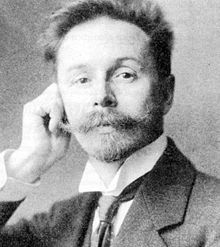 Romance, by Alexander Scriabin
Romance, by Alexander Scriabin
Transcribed for Clarinet or Flute or Alto Flute (and Piano) by J. W. Pratt
Parts, PDF $0.00
Alexander Scriabin (1872-1915), the mystic Russian composer with music to match, wrote nine mind-bending orchestral works and myriad mostly miniature piano pieces. He began as a "Russian Chopin" and ended planning a week-long "Mysterium" to be performed in the Himalayas using "an orchestra, a large mixed choir, an instrument with visual effects, dancers, a procession, incense, and ... mists and lights" (Wikipedia).
The Romance of 1890, his only chamber work except one variation for string quartet, is nearer the Chopin end of that spectrum, though the piano part adds harmonic and rhythmic complexities not evident from the solo part alone. —John W. Pratt, Jan. 19, 2016Please click on the links to download your free PDFs:
Transcription for clarinet required no changes of pitch. Scriabin - Romance - Clarinet
The transcription for flute is raised an octave, except the last five measures. Scriabin - Romance - Flute
The transcription for alto flute raises MM21-24 and MM36-48 an octave. Scriabin - Romance - Alto Flute
The piano score is freely available on IMSLP.org.
Scriabin image courtesy of Wikimedia.org, PD-old.
Slawinski - 5 Dessert Rounds - Two Flutes
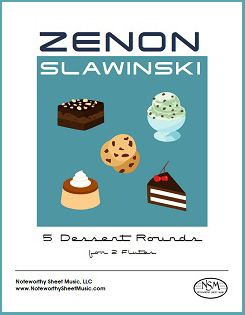 5 Dessert Rounds, by Zenon Slawinski
5 Dessert Rounds, by Zenon Slawinski
Contemporary Composition for Two Flutes
Score, PDF $4.99
Excerpts from the preface to the edition by Zenon Slawinski:
In most classic rounds the second voice begins and plays (or sings) the same melody as the first voice. That's the case here too for three of the five Dessert Rounds. Rounds 3 and 4 are different. In Round 3 - The Chocolate Chocolate Chip Cookie - the second voice plays the same melody but a third higher. In Round 4 - Sweet Potato Flan - the second voice plays the melody a 4th higher. // The Dessert Rounds are relatively simple and should not pose any difficulties for most intermediate players, although there are some tricky meter changes in Round 2 - Chocolate Mint Ice Dream - if you practice this slowly you'll soon be able to get past the meter changes and simply enjoy your dessert. // Round 4 - Sweet Potato Flan - is written in 7/4. // I purposely left off many performance markings so the players can make their own mark on the compositions. Interpret these pieces freely and have fun.
Zenon Slawinski, September 12, 2014
--------------------------------------------------------------------------------------------------------------
Click to listen to a few audio samples of the Dessert Rounds:
Score for two flutes, 6 pages; Total, 10 pages.
PreviewSlawinski - Bagette no. 4 - Flute & Piano
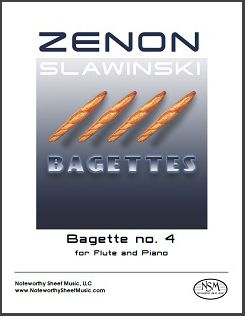 Bagette no. 4, by Zenon Slawinski
Bagette no. 4, by Zenon Slawinski
Contemporary Composition for Flute and Piano
Flute Part and Piano Score, PDF $16.99
Zenon Slawinski studied music theory and composition at the University of Michigan with Leslie Bassett, William Bolcom, and William Albright. He also studied Campanology with Hudson Ladd. After graduating with honors he pursued a career in both music and graphic design. Mr. Slawinski was co-music director for the Peabody and Ohio State award winning Children's Radio Theatre program, and scored numerous independent and industrial films and films for the Smithsonian Institution that aired at Smithsonian museums and on PBS. He wrote the music to the popular political talk show The John McLaughlin Group. Mr. Slawinski was a founding partner of a multimedia production company and recording studio working in the early interactive days on educational and entertainment music projects in the CDi and CD-ROM formats, many of which won numerous awards. For more details of Zenon Slawinski's biography, please see the Composers section of the NSM website.
Bagette no. 4 is from a set of four Bagettes written by Zenon Slawinski for his flutist wife, for the two of them to play together. The piece showcases the flute and has challenging moments for both players throughout. The spelling of "bagette" is intentional. The piece opens and closes with a quick ostinato in ¾ in the piano part that lays the foundation for the feel of the entire Bagette. The second section is more pensive and contemplative, with the piano taking the lead initially. The next section is bold and in a new key - B major - and here the flute and piano engage in a playful interaction. The composer intends for the players to put their own spin on the piece and interpret the music freely.
You may also listen to audio of the piece, recorded on the composer's Yamaha MOTIF ES with the sampled piano and flute sounds found in the instrument. Click to listen
Customers who purchase the sheet music to Bagette no. 4 are entitled to a free rehearsal mp3 of the piano track with which the flutist can play along.
Piano score, 15 pages; Flute part, 7 pages; Total, 26 pages.
PreviewSlawinski - Cookies - Flute & Piano
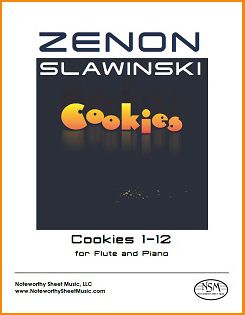 Cookies, by Zenon Slawinski
Cookies, by Zenon Slawinski
Contemporary Composition for Flute and Piano
Flute Part and Piano Score, PDF $24.50
From the preface by Zenon Slawinski:
The Cookies came about because my wife and I had been exploring the various compositions and arrangements available for flute and piano and I felt that we needed something new for our time and our audience. We live in a constantly changing world yet we love to hang our hat on the past, especially when it comes to music. I wanted to create a set of pieces that would not only be enjoyable for the listener but provide the players with a high level of satisfaction.
These pieces range in difficulty from the rather simple and easy to play (Cookies 1, 2, 4, 7), to the intermediate (Cookies 5, 8, 9, 11), and to the more challenging (Cookies 3, 6, 10, 12).
A special note about Cookie No. 5. This piece was influenced by the Jazz tunes in the popular series of Real Books which follow a common practice in today's "chart" or "lead sheets" where the melody line is written out and chords are marked for the accompaniment to play. This gives a lot of freedom initially to the piano. As the flutists becomes more familiar with their part, I would encourage them to get off the page and try some of their own lines.
I purposely gave few performance markings so that players can create their own. Interpret these freely and have fun.
Zenon Slawinski, September 17, 2014
You may listen to some short audio samples of the Cookies, recorded on the composer’s Yamaha MOTIF ES with the sampled piano and flute sounds found in the instrument.Cookie 2 mp3
Cookie 3 mp3
Cookie 9 mp3 Cookie 10 mp3
Customers who purchase the sheet music to Cookies are entitled to free rehearsal mp3’s of the piano tracks with which the flutist may play along.
Cookie 9 is a flute solo; the piano is tacet.
Cookies 1 to 12, complete edition: Piano score, 60 pages; Flute part, 21 pages; Total, 84 pages, PDF Price $24.50.Preview
For those who would prefer to buy a subset of the Cookies, rather than all 12, we offer three smaller editions:
Cookies 1,2,4,7: Piano Score, 15 pages; Flute part, 5 pages; Total 24 pages; PDF Price $9.45
Cookies 5,8,9,11: Piano Score, 15 pages; Flute part, 7 pages; Total 28 pages; PDF Price $9.45
Cookies 3,6,10,12: Piano Score, 30 pages; Flute part, 9 pages; Total 42 pages; PDF Price $18.90
Snow Pond Anthology—2015
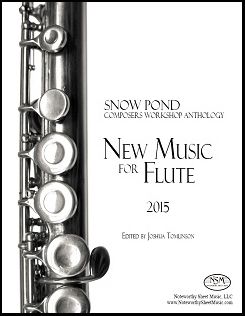 Snow Pond Composers Workshop Anthology New Music for Flute 2015
Snow Pond Composers Workshop Anthology New Music for Flute 2015
Edited by Joshua Tomlinson, PDF $21.95
The first annual Snow Pond Composers Workshop took place June 7-13, 2015, under the direction of Edward Jacobs and Richard Nelson. The workshop was part of the broader Snow Pond Music Festival taking place in Sidney, Maine. Peter H. Bloom was the Visiting Performing Artist, and Elliott Schwartz was the Guest Composer. The Snow Pond Composers Workshop Anthology—New Music for Flute 2015, edited by Joshua Tomlinson, includes all of the scores presented at the workshop:
ED by Sean O. G. Burns | one player, on flute with kick drum and voice
Where Wind Blows by William C. Edwards | solo flute
Farewell to Charms by Henry Feinberg | solo flute
Amuse-Bouche by Edward Jacobs | solo flute
Published by American Composers Alliance, reprinted with permission.
Stillness by Richard Nelson | trumpet, saxophone, guitar, bass, and drums/percussion;
or, flute and electric guitar (or other small combination of instruments)
Party On, Bloom! by Alan Racadag | one player, on piccolo, C-flute, alto flute,
and optional bass flute
Soliloquy III by Elliott Schwartz | one player, on flute, piccolo, alto flute, and piano
Published by American Composers Alliance, reprinted with permission.
Something Human by Joshua Tomlinson | solo flute
Indecision (...or maybe not) by Isaac Ward | solo flute
Vyvirian Folk Songs by Julian Ward | solo flute
Quicksilver by Joshua Zinn | solo flute
This is a remarkable collection of new music for flute, which Noteworthy Sheet Music is pleased to make available to the broader flute community. Our edition includes composer biographies and performance notes, as well as the scores.
Here's a YouTube link to a 9/23/2023 performance of ED by Peter H. Bloom:
Preview
Awarded 2018: Congratulations to composer Edward Jacobs on being awarded a prestigious Guggenheim Foundation Fellowship.
Tchaikovsky - The Nutcracker - Flute & Harp
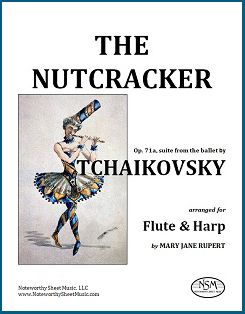 The Nutcracker, by P. Tchaikovsky
The Nutcracker, by P. Tchaikovsky
Arranged for Flute and Harp by Mary Jane Rupert
Flute Part and Harp Score, PDF $17.95 (also available as individual pieces)
Mary Jane Rupert, pianist and harpist, has performed as soloist, chamber musician, and orchestral player in many groups in the Boston area throughout the past three decades. She has toured the United States, Thailand, and New Zealand as a member of the duo "2" with flutist Peter Bloom, and performed with such other groups as the Southcoast Chamber Players, Musica Sacra, the Cecilia Society, and the Boston Philharmonic Orchestra. Educated at Oberlin College and Indiana University, Ms. Rupert earned a B.M. in piano, M.M. degrees in both harp and piano, and a doctorate in piano performance. Having taught at Western Michigan University, Oberlin College, and Wellesley College, she now maintains a private studio for both piano and harp in Cambridge, MA.
Dr. Rupert's superb arrangement of The Nutcracker for flute and harp includes all of the pieces from the original Suite Op.71a from the ballet by Tchaikovsky, except the Overture. Originally published in 1988 by New Boston Editions, the arrangement has been re-edited by Dr. Rupert and re-notated by NSM for this new edition, which is available as a PDF download. Professionals, students, and amateur musicians should all find uses for these popular pieces—as encores, recital pieces, and as part of the repertoire for more informal musical occasions.
Cynthia Price-Glynn, Principal Harp of the Boston Ballet and Chair of the Harp Department at the Boston Conservatory writes: "Mary Jane Rupert has done a masterful job of capturing the mood, attitude, and even humor of these pieces that are recognizable all year round. Her partnering of the two instruments actually mirrors the color and nuances of the original orchestration." Read the full review here.
Jan Jennings writes in The Harp Column: "Dr. Rupert uses enharmonics to play repeated notes cleanly and adds some p.d.l.t. sections for variety in "March." "Dance of the Sugar Plum Fairy" is a charming arrangement with the harp harmonizing with the flute in sixths. The harp is featured in measures 32-36 and brings to mind the original orchestration. "Trepak (Russian Dance)," "Arab Dance" and "Chinese Dance" are all pretty readily playable. "Dance of the Reed Flutes" is more challenging and the harp harmonizes with the flute in thirds. The signature piece of the suite is, of course, "Waltz of the Flowers" and includes the cadenza." Read the full review on The Harp Column website.
Complete Edition: Harp score, 44 pages; Flute part, 14 pages; Total, 64 pages. $17.95Preview
For anyone wishing to purchase individual pieces of Mary Jane Rupert's arrangement of The Nutcracker for flute and harp, rather than the entire suite, we also offer the seven pieces as separate PDF's. Just check the appropriate box in the Add to Cart table below:
==========================================================
We also offer a professionally-printed hard copy of the complete edition of The Nutcracker by Tchaikovsky, arranged for Flute and Harp for $33.33 plus a $5.95 shipping and handling fee to addresses in the USA. Use the Contact Us form to let us know which hard copy publication(s) you would like to purchase, along with your email contact information and USPS mailing address. We will then send you a PayPal invoice for the sale and, once we receive notice from PayPal that you have paid for the item(s), we will ship your music to the address provided.
